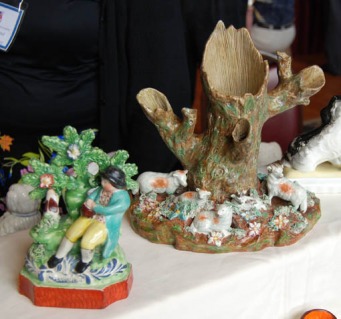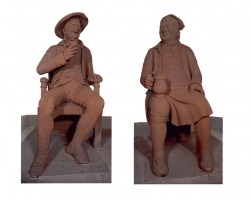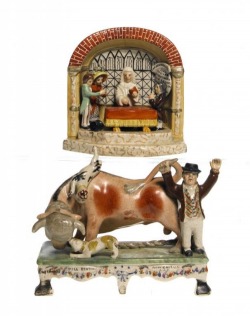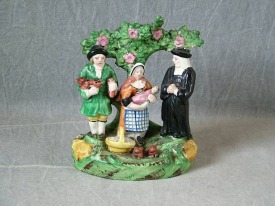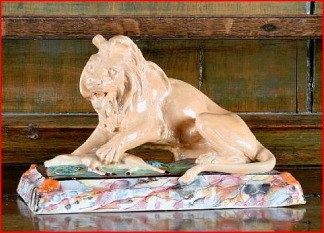When I first met my friend Nick Burton, he insisted on taking me to Newcastle-on-Lyme to see what he considered the ultimate Staffordshire menagerie. Beyond our reach, behind glass, was this exquisite diminutive menagerie, quite unlike anything I had seen before. It was a little Wombwell's menagerie and I had to remind Nick that it was pictured in Halfpenny--but a teensy picture did not begin to do this object justice. The figure group was simply mouthwatering delicious. So frustrating not to be able to touch.
Fast forward some years, and Nick was helping me photograph for my book. We had arranged an appointment at Newcastle-under-Lyme to photograph the very same menagerie, and another appointment at the Fitzwilliam Museum to photograph the only other known example of that menagerie. Of course, photographing gives opportunity to do more than click the camera, and often Nick had to prod me back into action as I stood mesmerized by a figure. Anyway, on that day, Nick and I both drooled over the little menageries and frankly it was hard to put each one down. At the end of the day, as we ate our curry dinner, we were still debating which was the better menagerie. Which should we use for the book? In the end, the choice was a coin toss. But we agreed that either little Wombwell's menagerie was THE ultimate figure.
Not all menageries are created equal.
1. Polito's menagerie comes in two sizes, achieved by putting the standard backplate onto varying base forms and modifying the cast of characters standing on the base. Always in the "Sherratt" style. About 13" high.
2. Wombwell's large menagerie. An adaptation of the Polito's menagerie, with a change in titling, obviously. Again always in the "Sherrat" style. Height just over 13"
3. Wombwell's tiny menagerie. Height just 81/2". Not attributable to "Sherratt." Particularly fine and probably a precursor to the "Sherratt" type menageries.
George Wombwell, by the way, was the 19th century's ultimate menagerist. As a young cobbler, he bought two boa constrictors off the London dock in 1805 and made so much money showing them that he was able to start up his own traveling menagerie. He died in 1850--by which time he had three menageries--but menageries bearing his name toured until around 1930. In the early 19th century, the opportunity to observe animal behavior appealed to people from all walks of life. Wombwell's was summoned to exhibit before royalty on several occasions. But for the average man in the street, the arrival of a menagerie in his village meant an opportunity to verify the existence of hitherto mythical beasts. This was the era before photography and most people hadn't even seen a drawing of some of the menagerie's animal stars. Can you imagine seeing a lion or camel for the very first time? Can you imagine having a giraffe or elephant on an English market square? Having a menagerie visit your village was a life changing experience. For the collector, having a menagerie enter your collection is still a life changing experience!
The first Staffordshire menagerie I ever saw was a rather life changing experience. I traveled to Toronto to look at and hopefully bid on a rather perfect Polito's menagerie. How foolishly innocent I was! I didn't even get to raise my hand during the auction--that menagerie is now in captivity at the Victoria and Albert Museum. It had been bought for GBP500 at Grosvenor House in the early 1970s. It made GBP30,000 or GBP40,000 on that day in Toronto. Toronto was miserable, and on the way back I had so many flight problems that I ended up sleeping the night on the airport floor. I may have returned home empty handed, but my head was full to overflowing. Bill Kime, Waddington's extraordinarily knowledgable, patient, and kind expert, had allowed me to examine that menagerie to my heart's delight. The miseries of the trip are long forgotten, but the sensation that seeped into my pores as I touched that sacred object will be with me always.
Read all about menageries in my book, People, Passions, Pastimes, and Pleasures: Staffordshire Figures 1810-1835. I found this subject gripping. Staffordshire figures of menageries and their captive (and sometime escaped!) animals are colorful time capsules packed with astonishing tales of a bygone era.


